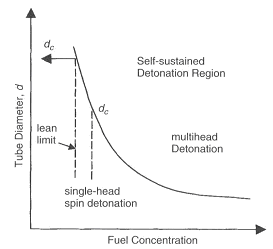
|
BRHS /
Detonation limitsExperiments show that there exist definite limits beyond which a detonation cannot exist. These depend on the composition, temperature and pressure of the mixture, and also on the geometry and roughness of the vessel. Approaching the detonation limits the detonation wave first begins to pulsate, becomes “multi-headed” and then changes its character completely: the detonation front starts to move along a helical path – this mode is called spinning detonation. Table 1 shows limits of detonability in comparison with deflagration limits which are wider. Detonability limits of confined mixtures are not unique, but strongly depend on the boundary conditions of the medium in which the detonation propagates. This is shown by the results of Table 1 from the experiments performed in tubes of different diameter. Table 1. Experimental deflagration and detonation limits for hydrogen.
 Figure 1. Effects of fuel concentration and tube diameter on the onset of single-head spin detonation (KuoKK:2005) Over the range of detonable concentrations of a given fuel-oxidizer mixture, the wave structure is called multi-head wave front. This wave is characterized by relatively weak transverse waves in compari-son to the axial component, which allows it to be considered roughly one-dimensional as in the ZND model. It has been observed that, in a given smooth circular tube, as the mixture composition becomes leaner or richer, the multi-head, self-sustained detonation becomes a single-head spinning detonation propagating at about the CJ velocity. The critical tube diameter dc for detonation propagation in un-confined space outside the tube was discovered which is related to the characteristic transverse wave spacing (detonation cell size) \lambda by:
A schematic illustration of wave motion in a detonation cell is shown in Figure 1 in article Detonation front structure. In Figure 1 the tube diameter is plotted against fuel concentration around the lean limit. In the region above the curve, known as the self-sustained detonation region, multi-head detonations propagate. As early as (KogarkoSM:1948) proposed that, at the onset of single-head spin in a smooth circular tube, the detonation cell width \lambda , must be equal to the tube circumference, \lambda = \pi d^*
This limiting tube diameter is designated as d*. Later this criterion was confirmed by (LeeJHS:1985) and (DupreG:1985). Figure 2 presents critical tube diameter for hydrogen and some hydrocarbon fuels and Figure 3 shows limiting tube diameter for same fuels.  Figure 2. Correlation of critical tube diameter with the empirical law d_c = 13 \lambda (KuoKK:2005)  Figure 3. Variation of the minimum limiting tube diameter d^* = \lambda / \pi for stable propagation of detonation in tube Kuo K.K. (2005) Principles of Combustion. John Wiley \& Sons, New York.(BibTeX) << Chapman-Jouget detonation | Content | Detonation front structure >> |
|||||||||||||||||||||||||||||||||||||||||||